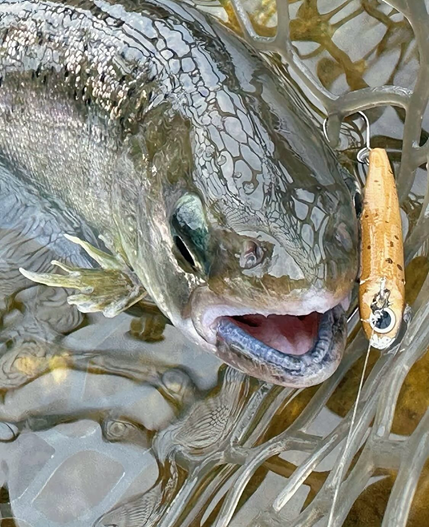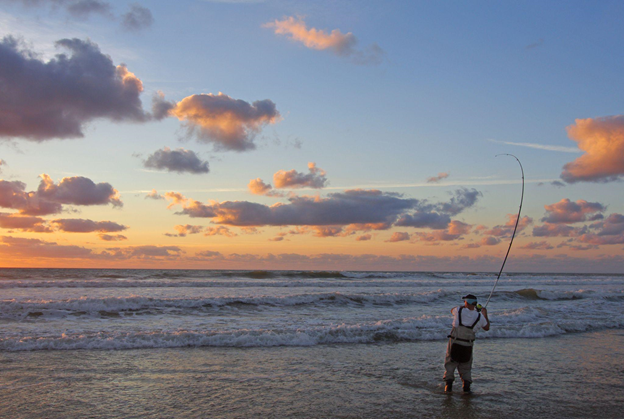Article: Trout Fishing Gear, Tools, and Extras You Won’t Want to Be Without

Trout Fishing Gear, Tools, and Extras You Won’t Want to Be Without
Just what you carry on the water, in terms of trout fishing gear, is best determined by experience. After you’ve spent a few seasons on the bank, you’ll get a good feel for what you really can’t be without, what’s just “nice to have,” and what weighs you down, the latter which you should probably leave at home.
That said, this checklist is a nice place to start.
Your Trout Fishing Rod and Reel Combo
Obviously, you can’t fish without your trout fishing rod and reel combo, inclusive of matched line and of course, trout fishing lures. That’s a topic for another article, though.
Tackle Bag or Box
Whether you’re a trout BFS angler or a fly guy, you need a way to store, organize and access your trout fishing lures or flies. Most anglers throwing metals and plugs store them in a box or tackle bag; most fly anglers either keep a fly box or a woollen fly patch on their vest.
Polarized Sunglasses
Specifically, polarized sunglasses are a must because they significantly cut back on glare, which not only reduces the strain on your eyes, it makes it much easier for you to see under the water, which is essential for sight fishing.
Essential Tools
Now let’s take a closer look at some of the trout fishing gear, specifically tools, that you’ll want to have with you.
Line Snips or Nippers
Will you survive a trip in the backcountry without a pair of line snips or nippers in your vest? Absolutely, especially as long as you brought a good knife. You could even use your teeth.
Carry a pair of line nippers or snips in your pocket or on your vest and you will wonder how you ever got along without one in the first place. You’ll be reaching for it to trim off your excess every single time you tie on a new trout fishing lure.
Forceps or a Disgorger
You’ll want some sort of dehooking tool like a disgorger, but a pair of forceps is better because they are not only less bulky and invasive (which is important for trout, who are highly susceptible to post-release mortality) but because they lock, which makes it easier to get a grip on the hook or lure you are trying to disgorge.
Pliers
A pair of pliers is less specialized than forceps or a disgorger, but it’s essential to have a good pair in the field because they have innumerable applications.
Knife
Never go afield without a knife. Whether for bait prep or meal prep, it’s your single most important, and by far your most versatile, piece of gear.
Landing Net
If you can land and release a trout without touching it, all the better, because handling fish is stressful for them and damages their slime coat, which is one of their first lines of defense against infection.
Another note: rubber nets are better than nylon or woven nets because the rubber is more gentle on the fish and won’t strip away the slime coat or dislodge scales.
Hook Hone
It might not seem like an indispensable piece of trout fishing gear, but a sticky sharp hook can be the difference between a short strike and a hooked fish. Check your trout fishing lures before every first cast, and after you catch a fish, and give each point a few passes on your hone to restore the point
Tape Measure or Scale
For those of you that catch to eat, a tape measure is necessary to ensure compliance with state laws and regulations.
As for a scale, you’ll be glad you brought it if you’re a catch and release fisherman and ever catch a true trophy. That way you can put a weight to the tale when asked about it.

Knot Tying Tool
A knot tying tool is not absolutely essential, but if you have room in your vest or pack for it it can come in handy.
Optional: Waders
Wading is not absolutely necessary, but some trout fishermen wade to get closer to fish as well as to access waters that would be difficult if not impossible to fish from the bank.
Your two main choices are chest waders and hip waders. Hip waders are suitable in shallower water, but for deeper and colder water, opt for chest waders.
If You Wade: Wading Belt
For those of you that choose to wade, make sure you wear a wading belt, especially in moving water. The belt cinches around your midsection and will help keep your waders from filling with water if you fall in - they can save your life.
For Those That Keep: Creel or Stringer
If you catch to keep, a creel or stringer is necessary; a creel will use evaporative cooling to keep the fish fresh, whereas a stringer can keep the trout alive until you get home. Either can be a viable option depending on your needs.
Explore Essential Trout Fishing Gear and Lures Here
Again, the best teacher for what you need to bring on the water is experience, but for now, this checklist is a good place to start. Stock up on essential trout fishing lures here, or prepare with a new trout rod and reel combo, and be ready for your next trip.

